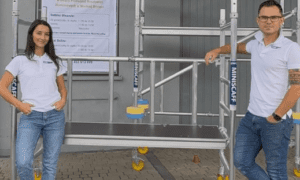Rethinking Sustainability on Construction Sites
Sustainability is no longer just a buzzword—it’s a necessity in today’s construction industry. As concerns over climate change grow, there’s an increasing focus on how industries can reduce their environmental footprint. Construction, traditionally known for high levels of waste and resource consumption, is under pressure to adapt and adopt more sustainable practices. This shift involves more than just choosing eco-friendly materials; it requires a fundamental change in how construction sites are managed, from planning to execution.
Construction management software plays a critical role in driving this change. By offering the tools to track resources, optimise workflows, and cut down on waste, these software solutions are helping builders and project managers make significant strides towards greener operations. When sustainability meets efficiency, it’s a win-win for both the environment and the bottom line.
The Challenges of Waste and Inefficiency in Construction
Construction sites are notorious for generating massive amounts of waste. Whether it’s leftover building materials, packaging, or other discarded items, construction projects often produce waste at every stage of development. Alongside this, inefficient resource usage—including energy, water, and raw materials—adds to both the environmental impact and the cost of projects.
Traditional construction methods rely heavily on manual tracking, which can lead to inaccuracies and overlooked inefficiencies. This is where construction management software steps in to make a real difference. The software offers an integrated platform to manage projects, track resources, and analyse waste, providing insights that help reduce material use and promote sustainability. By reducing reliance on spreadsheets and manual logging, construction management software makes the process of waste management and resource efficiency significantly easier and more precise.
Improving Material Tracking and Reducing Waste
One of the largest contributors to inefficiency on a construction site is poor material management. Overordering and underusing materials not only increase costs but also create significant amounts of waste. Construction management software allows project managers to accurately track material requirements throughout the project lifecycle.
Using digital takeoff tools, project managers can generate precise estimates of material needs, reducing the risk of over-purchasing. Furthermore, tracking systems embedded within construction management software help to monitor how materials are being used in real-time. By identifying which materials are over-ordered or underutilised, builders can make adjustments to minimise waste.
Beyond reducing initial waste, the software also helps in managing leftover materials more effectively. When surplus materials do arise, construction management software can log them for use in future projects rather than sending them straight to a landfill. This kind of smart tracking and reuse makes a huge impact on waste reduction and supports a more circular approach to resource management.
Streamlining Resource Efficiency with Smart Scheduling
Labour, equipment, and materials all need to be managed effectively for a project to run smoothly. The longer resources sit idle, the more money and energy are wasted. Construction management software provides project managers with intelligent scheduling tools that help make sure every resource is used as efficiently as possible.
By having a clear overview of project schedules, managers can ensure that the right number of workers are on-site at any given time and that machinery isn’t sitting unused. This reduces energy consumption and labour costs. Furthermore, streamlined scheduling ensures that work is carried out in a logical sequence, minimising the risk of rework—which is not only costly but also wasteful in terms of both time and materials.
Facilitating Sustainable Procurement
Sustainable construction begins with sustainable procurement. Choosing suppliers who prioritise eco-friendly practices, selecting materials that are sustainably sourced, and reducing the carbon footprint associated with delivery are all key aspects of building a greener construction site. Construction management software can facilitate sustainable procurement by providing access to supplier data, price lists, and tracking information in one place.
By comparing suppliers and materials based on sustainability criteria, project managers can make informed choices that align with environmental goals. Additionally, by using the software to plan procurement in advance, managers can group orders, reducing the number of deliveries required and thus cutting down on associated emissions.
Monitoring Energy Usage on Site
Energy consumption is a major part of a construction site’s environmental impact. Whether it’s the fuel used by heavy machinery or the electricity needed to run site offices, energy use needs to be closely monitored and optimised. Construction management software can help track energy usage and identify areas where consumption can be reduced.
For instance, by keeping a close eye on the utilisation of equipment, project managers can identify machinery that is consuming excessive fuel or electricity. They can then schedule maintenance to improve efficiency or replace old machinery with more energy-efficient options. Similarly, construction management software can help to track the energy used in temporary site facilities, making it easier to implement energy-saving measures such as switching to LED lighting or using solar-powered equipment.
Encouraging Better Waste Management Practices
Effective waste management goes beyond simply reducing the amount of material used on-site. It also involves ensuring that any waste generated is disposed of responsibly. Construction management software provides tools to log waste as it is produced, allowing project managers to assess the types and quantities of waste generated and find opportunities to recycle or reuse materials.
By having a clear understanding of what waste is being produced, teams can identify inefficiencies in their processes and improve waste management practices. Software also allows the tracking of waste disposal, ensuring that all waste is managed in compliance with local regulations and in the most environmentally friendly way possible. By having a waste management plan embedded in the project workflow, sustainability becomes an integral part of the construction process, rather than an afterthought.
Reporting and Continuous Improvement
Sustainable construction requires ongoing effort and continuous improvement. Construction management software provides a wealth of data that can be used to measure the success of sustainability initiatives and make informed adjustments for future projects. Detailed reporting features allow project managers to analyse resource consumption, waste production, and energy usage over the course of a project.
These insights are invaluable when it comes to improving future projects. For example, if data shows that a particular material consistently leads to a high level of waste, project managers can look into alternative materials or methods that might be more efficient. By using historical data to inform decision-making, construction companies can ensure that each new project is more sustainable than the last.
Conclusion: Leveraging Construction Management Software for Sustainable Success
Creating a sustainable construction site involves more than just using green materials—it’s about changing how every aspect of a project is managed to reduce waste, improve resource efficiency, and minimise the overall environmental footprint. Construction management software is an essential tool in achieving these goals. By providing real-time data, optimising resource use, and facilitating better planning, it makes the task of creating a greener construction process both achievable and practical.
In the drive towards sustainability, technology is proving to be one of the construction industry’s greatest allies. By incorporating construction management software into daily operations, companies are better equipped to track their impact, make smarter choices, and move towards a more efficient and environmentally responsible future. With these tools in place, building sustainably becomes less of a challenge and more of an opportunity to innovate and improve, benefiting not only the environment but also the business itself.

































